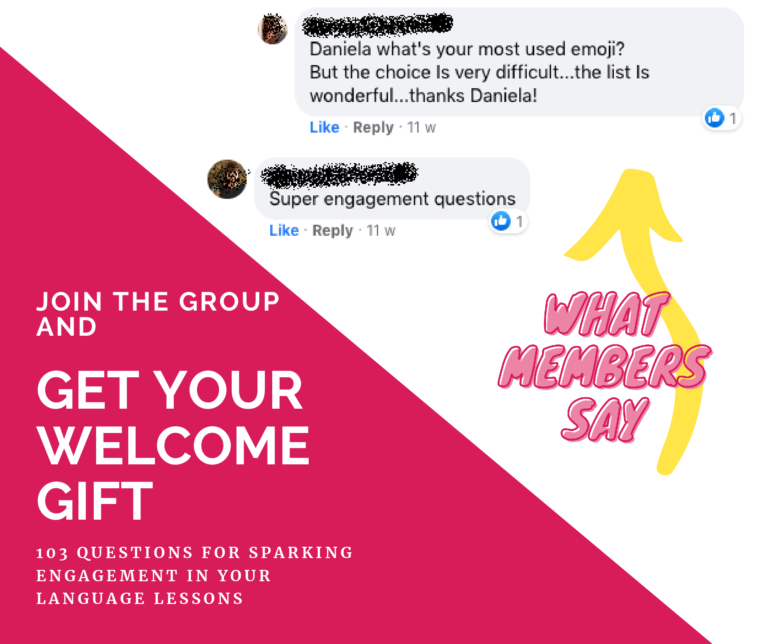
Writing a lesson plan shouldn’t be nor overwhelming nor boring. Instead, writing a lesson should be a creative task that helps you to unleash your true potential as a language teacher.
Yes, you could just tap into libraries of ready-made lesson plans. Yes, you could just copy someone else’s lesson plans and make them work for your classes. But the question is:
Where is you in all this?
How does your personality, your enthusiasm, your leadership come out? Copying lesson plans or delivering ready-made lessons plans is a strategy that works if you are really in a rush or need fresh ideas quickly. It is not a long-term strategy I would recommend, though.
I wrote this post because I want to help language teachers to finally stop feeling overwhelmed by lesson planning so they can unleash their creativity and true potential as a language teachers.
The plan is an easy one. It consists of three steps.
This is what I mean by writing a lesson plan that comes from your heart and soul!
Writing a lesson plan by sticking to a method will save you hours of work
It’s all about the method, really. If you know how the acquisition process works and how this reflects into a lesson plan, then you have got the key for designing awesome lessons in no time. What is the best method for writing a lesson plan? My suggestion is to stick to the Acquisition Unit and Didactic Unit structures.
A lesson plan is grid reflecting a sequence of six phases: the acquisition process phases, indeed. The six phases are:
- Engage
- Globality
- Analysis
- Synthesis
- Discussion
- Assessment
You don’t have to cover all the six phases every time you deliver a lesson. In fact, you could decide to spend an entire lesson on “Engage” and then two lessons on “Globality”, for instance. Your decision is down to your students’ needs and the training goals you set for the course.
When you are clear on the acquisition process and how this reflects in a lesson plan, then picking the right activities/exercises and bringing them together within a lesson plan comes smoothly – I promise!
Writing a lesson plan comes after setting the metrics
Don’t forget about the metrics! Always start planning a lesson by setting the acquisition goals and by setting the metrics, too. What does setting the metrics mean? It means you need to decide on the way you will be evaluating your students’ performance and achievements. This could consist in a formal assessment, or in a group activity you’ll be observing, for instance.
Ask yourself: how will I know my students have achieved the expected results? What type of tool will I be using for assessing their performances? What type of behaviour am I expecting to observe? And how will I evaluate the behaviour?
Writing a lesson plan with the end in mind
Talking about goals and metrics, remember to set the acquisition goals as follows:
- Minimum achievement
- Expected achievement
- Over-achievement.
This will help you to diversify the exercises and the activities you want to put into the lesson plan in order to meet everyone’s needs and skills.
Ask yourself: do I want to create an obstacles course challenge for my students, or do I want to create a learning experience?
If your intention is to create an obstacles course challenge where only the smartest and the fastest students will make it to the end, then set only one metric: either the students pass the final assessment, or they fail it. Easy.
On the other hand, if you intend to create a learning experience, you should do this in the respect of every student’s pace. Each student will be progressing at their own pace. That is the reason why I recommend to set a set of goals rather than a unique goal for the lesson. For instance:
- Minimum achievement = students can use the new vocabulary in basic sentences
- Expected achievement = students can use the new vocabulary in basic sentences and short dialogues starting from structured role-plays
- Over-achievement = students can improvise short dialogues.
Wrapping up
Three keywords for you to bear in mind when you are writing a lesson plan:
- Method (a framework, a grid)
- Metrics (start with the end in mind)
- Graduated goals (respect your students’ pace).
Three tips for unleashing your true potential as a language teacher. Enjoy lesson planning and shine!
Want more support?
Join the Facebook group Independent Language Teachers Collective to get daily advice, tons of free training and to branch out with other independent language teachers like you!
ALSO…
Available only for the Collective members: free list 103 question for sparking engagement in your language lessons.
This is what members say about the freebie:

Join in the Collective and grab your welcome gift:


